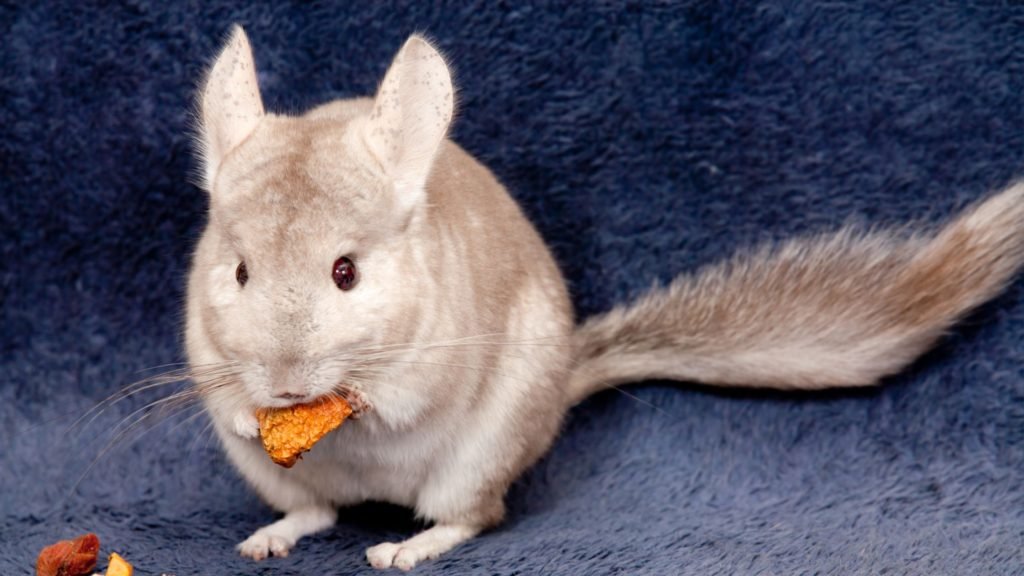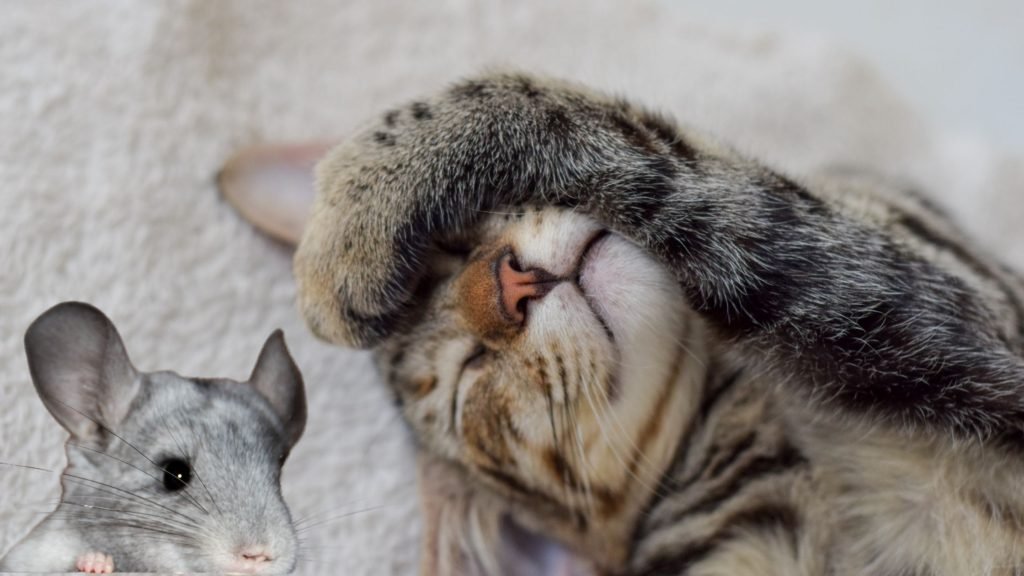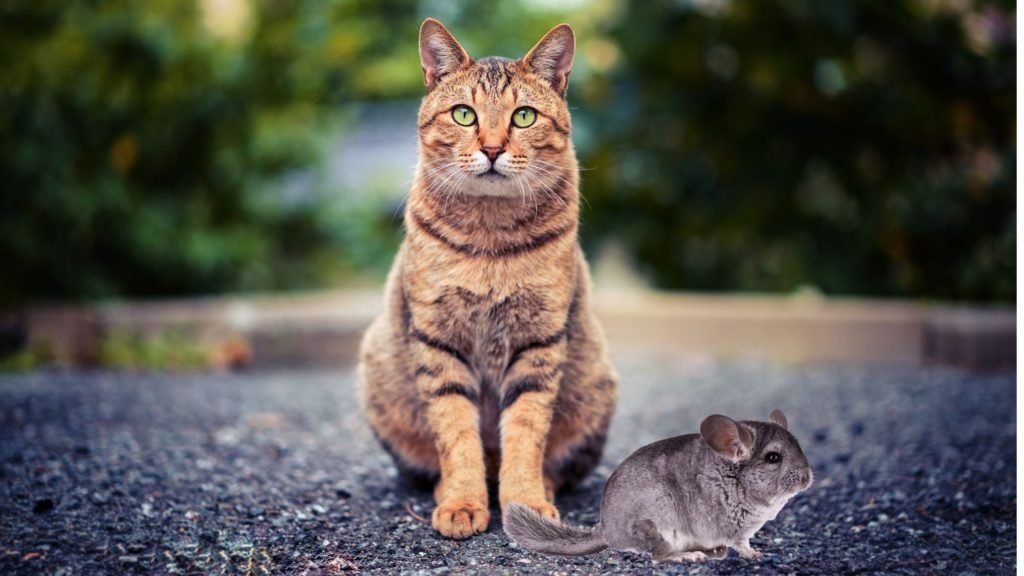Dive into chinchilla with cats cohabitation: Learn expert tips and strategies to foster a loving, harmonious bond between these enchanting pets in your home. A menagerie of beautiful creatures, our homes have become sanctuaries for various animal companions. Among the myriad species, chinchillas and cats have captured the hearts of many pet enthusiasts.
Their coexistence, however, raises a problem that warrants a thorough investigation. As we embark on this fascinating journey, we will delve into the subtleties and nuances that underscore the interactions between these two captivating creatures. We aim to comprehend their behaviors and unravel the complexities of their compatibility as housemates.
Chinchillas: Nature's Whimsical Creations

Physical Features
With their panache for the adorable, Chinchillas sport many enchanting physical attributes. They have one of the world’s softest furs despite their small size. Behind the silky tufts, expressive black eyes and large, rounded ears make them alluring. Their bushy tails, reminiscent of a feather duster, complete the portrait of these beguiling animals.
Behavior and Habitat
Hailing from the unsteady terrain of the Andes Mountains in South America, chinchillas have evolved to become masters of agility and speed. Their natural habitat is characterized by rocky, arid landscapes, which have endowed them with a penchant for climbing and burrowing. They are most active around dusk, alternating between frantic activity and peaceful relaxation.
Domestication
The charm of chinchillas has not gone unnoticed by humans, leading to their domestication and subsequent adoption as endearing companions. Pet lovers adore these little rodents, first produced in captivity in the early 20th century. Their unique personalities and relatively low-maintenance care requirements have solidified their status as cherished household additions.
You May Also Interest: Unveiling the Rainbow: Exploring What Colors do Cats See
Cats: Enigmatic Feline Companions
Domestic Cats
The domestic cat, a paragon of grace and mystery, has long shared an enduring bond with humans. With a lineage tracing back to the African wildcat, these feline muses have been immortalized in art, literature, and folklore. They continue to captivate us today with their independent spirit and mysterious demeanor.
Physical Features
Cats have lithe, muscular bodies and silky coats with various colors and patterns. Their arresting eyes, often aglow with an inner fire, serve as windows into the enigmatic feline soul. With their dexterous paws and twisted tails, cats effortlessly navigate their environment, exuding an air of quiet confidence.
Behavior and Habitat
Cats are versatile creatures that thrive in many habitats, from urban jungles to sprawling countryside. They are skilled hunters with predatory instincts that belie their domesticated status. As masters of slumber, cats can sleep for up to 16 hours a day, interspersed with bursts of energy and playfulness. Their social structures are variable, with some preferring isolation and others seeking human and feline interaction.
Chinchilla with cats: Natural Instincts and Behavior
The Hunter’s Prowess: Predatory Instincts of Cats
Cats, ancestors of the African wildcat, have a natural predatory instinct. Their finely-tuned senses and their agile physiques render them formidable hunters. Cats smoothly stalk their prey, each planned action resembling their wild origins. These tendencies appear in playful pounces and intense gazes on possible targets, even at home.
The Art of Evasion: Prey Instincts of Chinchillas
Chinchillas, though small in stature, are well-versed in the art of evasion. Generations of exploring predator-filled settings have sharpened their senses and limbs. Chinchillas use their bushy tails as a rudder to leap to safety. Their propensity for burrowing, too, provides a sanctuary from the clutches of would-be assailants. Even in the domestic sphere, chinchillas retain their instincts to flee and hide, ever-vigilant in the pursuit of self-preservation.
A Delicate Balance: Potential Challenges in Chinchilla and Cat Interactions
Chinchillas and cats’ contrasting tendencies make living together a tricky dance. The cat’s predation and the chinchilla’s flight create a dynamic interaction. Pet owners must be aware of these subtleties since the balance between friendship and rivalry may shift quickly.
You May Also Interest: Long Tailed Cat Breeds: A Visual Feast of Feline Elegance
Chinchilla with Cats: Factors Affecting Compatibility

Feline Mosaic: Cat Breed and Temperament
Cat breeds have a wide range of personalities. Cat-chinchilla compatibility depends on their characters, from the Siamese’s laziness to the Maine Coon’s exuberance. Some species like hunting more than others. In the dance of interspecies compatibility, a discerning cat owner must embrace the unique characteristics of each kitty.
The Chinchilla Enigma: Unraveling Personality
Though diminutive in size, chinchillas boast personalities that defy their small stature. From assertive and exuberant to timid and reticent, their temperaments complicate cat relationships. A harmonious coexistence requires a keen understanding of the chinchilla’s disposition and an ability to adapt to its ever-evolving needs. Pet owners build trust and learn as they discover their chinchilla’s heart.
Chinchilla with cats: Environmental Factors
Housing and Space
The alchemy of chinchilla and cat cohabitation is inexorably intertwined with the environment in which they reside. Ample space, an essential ingredient in this delicate concoction, allows animals to carve out their sanctuary. Ensuring separate and secure housing for chinchillas is paramount, providing them a refuge from the watchful eyes of their feline housemates. Conversely, cats must be afforded their realm to roam and explore, unhindered by the constraints of shared territory.
Toys and Distractions
A cornucopia of toys and distractions is vital in the tapestry of interspecies compatibility. Engaging a cat’s predatory instincts with various interactive playthings can redirect their focus away from their chinchilla counterparts. Providing chinchillas with various exciting activities can satisfy their infinite curiosity and energy, making them feel safe. Pet owners skillfully weave these components into their animals’ life, creating a harmonious mosaic that honors interspecies connections.
Strategies for Introducing Chinchilla with Cats
The Dance of Acquaintance: Gradual Introductions
The union of chinchillas and cats is akin to an intricate dance, a delicate ballet of glances and gestures that must be choreographed precisely. Gradual introductions are the overture to this performance, allowing each animal the time to acclimate to the other’s presence. A symphony of scents and sounds may precede the first visual encounter, whetting their curiosity and tempering the novelty of this interspecies introduction. As the pas de deux unfolds, pet owners must remain vigilant and poised to intervene should the dance falter or lose its rhythm.
Decoding the Silent Language: Monitoring Body Language and Stress Signals
The language of animals is a subtle and enigmatic dialogue, spoken in whispers and conveyed through the merest flick of a tail or twitch of an ear. Pet owners must become adept at decoding these silent signals in the delicate process of forging a bond between chinchillas and cats. Monitoring body language and stress cues is crucial in gauging the success of their interactions, with each twitch and tremble as a barometer of their burgeoning relationship. As pet owners learn to decipher these secret messages, they unlock the secrets to harmonious coexistence.
Drawing the Lines: Establishing Boundaries
In the intricate waltz of chinchilla and cat cohabitation, boundaries serve as the framework upon which a stable relationship is built. Establishing these invisible lines, both spatial and behavioral, fosters an environment of mutual respect and understanding. Cats must learn to temper their predatory instincts, while chinchillas must acclimate to the presence of a potential threat. As pet owners deftly navigate this delicate balance, they lay the foundation for a lasting partnership between these enchanting creatures.
A Refuge in the Storm: Ensuring Safe Spaces for Both Animals
In the ever-evolving dance of interspecies relationships, the assurance of sanctuary is paramount. Safe spaces, havens where chinchillas and cats can retreat, are vital components of a harmonious household. For chinchillas, secure enclosures and hiding spots provide a respite from the watchful gaze of their feline companions. Cats, too, must be afforded their sanctuaries, where they can indulge in the luxury of solitude and repose. As pet owners weave these havens into the tapestry of their homes, they create an environment in which trust and understanding can flourish, nourishing the roots of a beautiful and lasting friendship.

You May Also Interest: Cat Body Language Tail: How to Speak Fluent Feline
Chinchilla with cats: Tips for a Harmonious Coexistence
Realms of Solitude: Providing Separate Living Areas
In the intricate ballet of chinchilla and cat cohabitation, separate living areas are the foundation upon which harmony is built. These realms of solitude, sanctuaries tailored to the unique needs of each animal, provide a respite from the whirlwind of interspecies interactions. By carving out spaces dedicated to their pursuits, pet owners nurture an environment where mutual respect and understanding can blossom, fostering a delicate balance between companionship and independence.
The Art of Observation: Supervising Interactions
As chinchillas and cats wend their way through the labyrinth of shared experiences, pet owners must cultivate the art of observation. Supervising interactions, a vital component in maintaining harmony, allows pet owners to discern the subtle nuances of their animals’ behavior. By closely monitoring these encounters, they can intervene at the first sign of discord, defusing tensions before they escalate into conflict. In this delicate dance, the watchful gaze of the pet owner serves as a guiding hand, steering the course of the relationship toward a harmonious future.
The Alchemy of Affection: Encouraging Positive Associations
To foster a lasting bond between chinchillas and cats, pet owners must become alchemists of affection, skillfully weaving a tapestry of positive associations. Treats, praise, and a gentle touch can serve as catalysts, transforming the raw materials of curiosity and caution into a golden bond of friendship. By rewarding their animals for calm and respectful behavior, pet owners reinforce the foundations of harmony, kindling the embers of trust and understanding to sustain their interspecies relationship.
Heeding the Whispers of the Heart: Recognizing Signs of Stress or Aggression
In the intricate language of chinchilla and cat communication, signs of stress or aggression often manifest as whispers of the heart, subtle cues that hint at the turmoil within. Pet owners must learn to recognize these delicate signals, from the bristle of fur to the flicker of a tail, to maintain the delicate balance of their interspecies relationship. By heeding these whispered warnings, they can adapt their approach and environment to address the needs of their animal companions, nurturing a harmonious coexistence that transcends the boundaries of species.
Chinchilla with cats: Potential Risks and Precautions
The Price of Discord: Injuries and Stress-Related Health Issues
The delicate balance of chinchilla and cat cohabitation teeters precariously on the edge of harmony and discord, with potential risks lurking in the shadows of their interactions. Injuries and stress-related health issues are the unfortunate price of missteps in this intricate dance, a stark reminder of the fragility of interspecies relationships. Pet owners must remain vigilant and attuned to the subtlest changes in their animals’ behavior and well-being. In doing so, they can intervene before conflict ripples to manifest in physical or emotional harm, preserving the delicate equilibrium that sustains their bond.
The Perils of Freedom: Escapes and Accidents
In the labyrinthine landscape of shared living spaces, chinchillas and cats face the ever-present specter of escapes and accidents. The adventurous spirit of these animals, coupled with their innate curiosity, can lead to precarious situations fraught with danger. Pet owners must exercise caution, ensuring their environment is secure and free from potential hazards. By remaining attentive to the shifting dynamics of their animals’ interactions, they can preemptively address potential threats, safeguarding the sanctity of their interspecies relationship.
A Stitch in Time: Minimizing Risks through Proper Supervision and Management
The key to minimizing the risks inherent in chinchilla with cats cohabitation lies in proper supervision and management, a delicate dance of vigilance and adaptability. By closely monitoring their animals’ interactions, pet owners can defuse tensions before they escalate into conflict or harm. In addition, by cultivating an environment that caters to both animals’ unique needs and instincts, they create a sanctuary in which trust and understanding can flourish as pet owners weave these threads of precaution into the fabric of their daily lives, they ensure that the tapestry of their interspecies relationship remains intact, a testament to the resilience and beauty of the bond that unites them.

